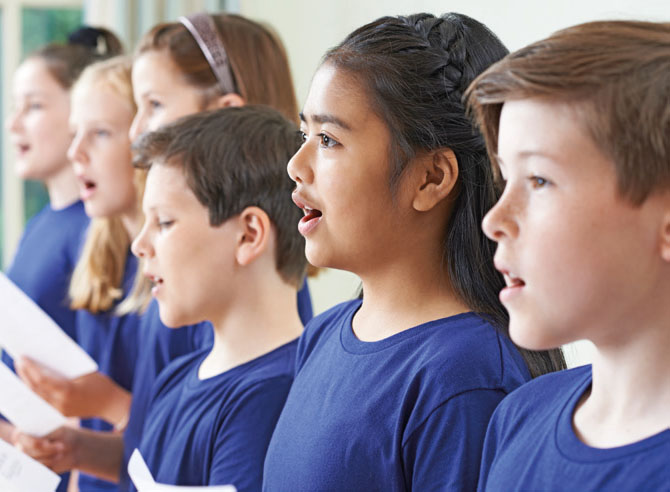Singing technique for shows: Vocal health
Sara-Lois Cunningham
Saturday, September 1, 2018
It's not uncommon for professional singers to drop out of performances at the last second due to concerns about their vocal health, so the risk for amateur singers should be apparent. Sara-Lois Cunningham looks at some things to bear in mind when preparing for a school show.

Marc Kirsten
For many schools, putting on a show is one of the highlights of the year. The students who take part will likely remember the experience for the rest of their lives. But whether that memory is one of total triumph, or of a struggle against adversity, will depend on the choices and strategies followed by the music director. Good decision-making can ensure that young singers maintain a healthy and convincing voice right through a run of performances.
Your first decision will inevitably be the choice of show: this should reflect the singers you have, both in terms of roles and overall suitability. But, when casting, be thoughtful. Janet Shell, a former head of music turned professional singer and singing teacher, advises against going automatically for whoever has the strongest voice. ‘People grow into roles in surprising ways. Check instead that the person has the range needed without pushing, even if their voice sounds a bit delicate.’
Making good choices about the band can make the difference between singers triumphing or struggling on stage. Shell says: ‘Keep the balance in favour of the singers when you get the band or orchestra, otherwise singers will push their voices like crazy.’
In general, the musical director needs to check that singers aren't pushing or forcing their voices. Some students may begin to use ‘belt’, which has the strident quality associated with modern musical theatre. Shell says: ‘Most people default to belt when they get scared of a high note or want to sing a low note loudly. If the singer can move into that register comfortably and can move out of it into what I call a mixed belt, I have tended to allow them to use this. It can add flare.’
But if you are unsure as to what constitutes safe belt, be very careful unless you have sound advice from a well-reputed singing teacher. Voice educator Jeremy Fisher of Vocal Process says: ‘Belting is a contentious issue for teenagers. Everyone wants to do it but many don't yet have the vocal stamina or fully formed laryngeal muscles to do so.’ His advice is that a bright, forward-calling sound is a good replacement and is easier on the voice for most teenagers.

© FOTOLIA
In any case, technology has ramped up in so many ways that the idea of singers trying hard to be heard may well be redundant: ‘D/deaf Aunt Sally on the back row now has a state-ofthe-art hearing aid so you don't need to reach her,’ says Fisher. ‘Many shows use a microphone system, in which case remember the “listener's ear” is only a few centimetres from the singer's mouth. Your singers can easily project their energy and performance without pushing for volume.’
Warm-ups are an essential part of the musical director's toolkit. Five to ten minutes of warm-ups can make a huge difference to the sound and longevity of the voice – and ultimately the vocal ease of the singers taking part. Also spend a few minutes at the end of rehearsals on warm-downs, which will gently guide the singers’ voices back to spoken-voice level.
‘Warm-ups need to be geared to the show's musical content,’ says Fisher, ‘not just random classical scales. Find small music patterns from the songs in the show and move them up and down in semitones, or work them in harmony. Notice the show's pitch range for male and female roles, and use sliding fifths or octaves to warm up that range plus a tone either way.’ Importantly, he says: ‘No one gets points for screaming into the stratosphere.’
Fisher observes: ‘Musical directors are usually excellent musicians, but they don't always know the finer details of vocal techniques for children and teenagers. All teenagers go through major hormonal changes in puberty that affect their vocal folds and larynx. Their pitch range, dynamic range and stamina are often not fully developed even by 18.’
Fisher recommends that keys of songs are adapted to suit the singers: ‘It helps to change keys as appropriate – the keyboard transpose button and digital programs such as Sibelius or Dorico are your friends here. For some teenage boys, voice change could leave them temporarily with a range of only a sixth, so work the song keys to fit the singers, not the other way around.’
With the above in mind, singers in their school years should sing for relatively short periods of time, so make sure they are not singing for an entire morning: try to alternate between cast members, and between solos and chorus numbers. Janet Shell recommends starting each rehearsal with a musical run-through of relevant scenes to focus on what is required: ‘In professional shows, rehearsal schedules are carefully worked out to get through the whole show and not leave cast members waiting all day. This is not always possible in schools. But having the confidence to block so everybody knows the shapes as soon as possible will help students have an overall view. After that, adding detail is the fun part.’

